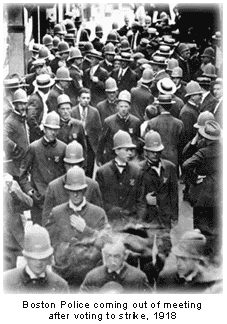By the fall of 1919, a series of strikes had hit the United States as unions attempted to gain higher wages to adjust for wartime inflation. Collective bargaining had long been viewed with suspicion by many Americans, whose suspicions were heightened by the worker revolution in Russia and efforts to spread communism throughout the Western world.
 In Boston, the largely Irish-American police force had seen its wages lag badly during the war. Efforts were made to organize in order to gain not only higher pay, but shorter hours and better working conditions. Police Commissioner Edwin U. Curtis refused to sanction a police union and suspended the leaders from the force in August 1919.
On September 9, more than 1,100 officers went out on strike, which removed three-fourths of the force from the city’s streets. Rabble-rousing Bostonians took advantage of the lack of authority and rioted. On the following day, Mayor Andrew J. Peters summoned local militia units, which managed to restore order.
At this juncture, Governor Calvin Coolidge, elected the previous November, decided to enter the picture after having passed up an earlier opportunity to resolve the matter. Coolidge summoned the entire Massachusetts Guard — a show of force that rapidly caused the strike to collapse and earned for the governor the reputation of a strict enforcer of law and order.
The striking policemen were not allowed to recover their jobs, which went overwhelmingly to returning servicemen. The new officers were granted higher pay and additional holidays, and gained the additional benefit of free uniforms.
Coolidge defended the decision not to rehire the strikers in a remark to Samuel Gompers, the head of the American Federation of Labor, proclaiming, “There is no right to strike against the public safety by anybody, anywhere, any time.”
Coolidge’s strong action was soothing to a fearful public and led to his nomination for the vice presidency in 1920. Most of the postwar strikes in the United States were unsuccessful and ushered in a decade of declining union membership. Public fears about radicalism continued to mount however, which resulted in the so-called Red Scare of 1919-20.
In Boston, the largely Irish-American police force had seen its wages lag badly during the war. Efforts were made to organize in order to gain not only higher pay, but shorter hours and better working conditions. Police Commissioner Edwin U. Curtis refused to sanction a police union and suspended the leaders from the force in August 1919.
On September 9, more than 1,100 officers went out on strike, which removed three-fourths of the force from the city’s streets. Rabble-rousing Bostonians took advantage of the lack of authority and rioted. On the following day, Mayor Andrew J. Peters summoned local militia units, which managed to restore order.
At this juncture, Governor Calvin Coolidge, elected the previous November, decided to enter the picture after having passed up an earlier opportunity to resolve the matter. Coolidge summoned the entire Massachusetts Guard — a show of force that rapidly caused the strike to collapse and earned for the governor the reputation of a strict enforcer of law and order.
The striking policemen were not allowed to recover their jobs, which went overwhelmingly to returning servicemen. The new officers were granted higher pay and additional holidays, and gained the additional benefit of free uniforms.
Coolidge defended the decision not to rehire the strikers in a remark to Samuel Gompers, the head of the American Federation of Labor, proclaiming, “There is no right to strike against the public safety by anybody, anywhere, any time.”
Coolidge’s strong action was soothing to a fearful public and led to his nomination for the vice presidency in 1920. Most of the postwar strikes in the United States were unsuccessful and ushered in a decade of declining union membership. Public fears about radicalism continued to mount however, which resulted in the so-called Red Scare of 1919-20.